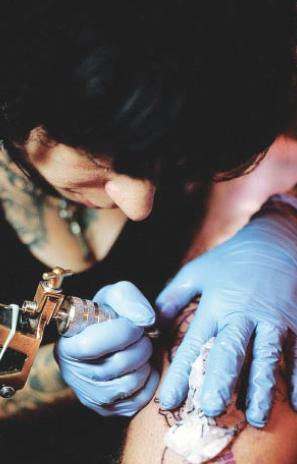Interview by Elvire Camus & Arnaud Aubry

Sue Jeiven, tattoist at East River Tattoo, using a coil tattoo machine, the main tool of the trade. Photo by Sofia Faga
Mary Kosut has a PhD in Sociology and teaches at SUNY Purchase College. In WG’s search for a more studied view of the “tattoo phenomenon” in Williamsburg, we tapped Dr. Kosut for her knowledge of the sociology of the body—tattoos especially.
WG: Originally, tattoos were for sailors, criminals, and other social outsiders. Are tattoos still a mark of belonging to a clearly defined social group, or has the trend really hit the mainstream in the US?
Dr. Mary Kosut: Tattoos have had currency among groups like sailors and social outcasts like criminals, but they have always functioned in a highly individualized way as well. The short answer is, yes, tattoos can but don’t always define people as part of a group—of course, they can be used as a marker of separation or distinction from others. As for the “trend really hitting the mainstream,” most statistics found in the mainstream press report that 25 percent of Americans between the ages of 18 and 35 have at least one tattoo. This indicates a significant shift compared to say 20 or 30 years ago.
That said, the term “mainstream” is fairly vague and problematic. Just because tattoos may be more prevalent in the media (on celebrities), and are more often found today on the bodies of the more socioeconomically advantaged, doesn’t mean that they are even close to being widely or universally accepted. For example, hand or neck tattoos are likely to be read differently in Williamsburg than they are in other less cosmopolitan neighborhoods. Within the “Bedford Ave” mainstream, a tat of a skull smoking a cigarette on your arm, or FML on your chest, may open a few doors (or at least up the chance of a buy back).
WG: Is tattooing a trend that will stop being fashionable soon, or is it more deeply rooted in American culture?
Dr. K: The notion of tats as trendy is problematic. They have certainly increased in popularity, but the definition of a “trend,” as something that is inherently fashionable which is by definition short lived and transient, does not apply to tattoos. By and large tattoos are permanent, as they are written into the body and not worn on top like gigantic 1970s sunglasses or a carefully culled Duran Duran tee. They are not as “disposable” as other kinds of self-presentation.
WG: How did tattoos become so mainstream so fast. Did something trigger the phenomenon in Williamsburg?
Dr. K: Well, I could take a guess regarding the Williamsburg tat trigger—but it would be like saying maybe playing kickball in McCarren Park promotes existential crises, or claiming that eating fish tacos triggers a Moby Dick complex.
WG: Why do Williamsburg hipsters get traditional American or Japanese tattoos? What do these foreign symbols say to them?
Dr. K: From my standpoint, traditional tats, whether Japanese or American, just look good and stand the test of time—a rose or a swallow are classic symbols that can represent anything to anyone. An evil wizard clown or a geeky internet reference could be the best tat ever for that individual—I don’t know. Based on my extensive research, “tattoo regret” is more prevalent when people wander farther away from the traditional art and craft of tattoo.
WG: Is getting a tattoo still a way to express a rebellion, or is it the opposite? Do hipsters get tattoos to “fit in” now? Has the exception truly become the norm?
Dr. K: Sure, some tats can be read as “rebellious”— a spider below your eye will probably do the trick. A little flowery design on the ankle is another story… They can work as marks of exclusion or inclusion, or both—it all depends. The tat AND the social context tell all.
Nowadays, tattooists are called artists. How has this cultural behavior moved from craft to art? Some say the legalization of tattooing, at the end of the 1990s has changed its status and permitted its democratization.
WG: Do you think the legalization could also be a reason for its change in status?
Dr. K: I have found no causal or direct link between the legalization of tattoos and aestheticization. One notable factor that has influenced the idea of tattoos as “art” (rather than a lowbrow craft or “deviant” subcultural tradition) is the influx of people with academic training who have “migrated” into tattooing as a means to make a living and do something that is creative. Since the 1970s, there has been a dramatic increase in graduates with BFAs and MFAs that the “artworld” simply cannot absorb.
WG: Do you think “extreme“ body modification such as putting metal crests under one’s skin could be the next step? Could it ever become as mainstream as tattoos gradually became?
Dr. K: Simply put, no, tattoos are not a “gateway drug” to more extreme modes like subdermal implants or amputations. Extreme body modification is something else entirely.
Leave a Reply